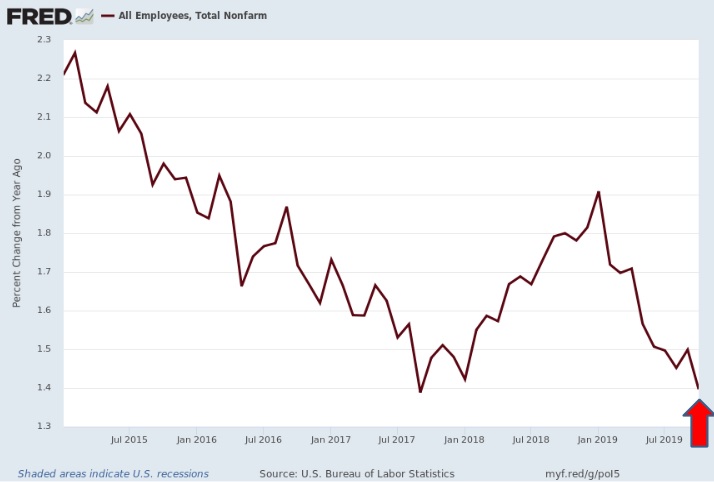The October employment numbers elicited an unexpected response from the White House. It was not enough just to cheer the good news that the October employment gain of 128,000 workers was better than expected and the employment counts for August and September had been revised to add 95,000 additional workers. Instead, President Trump tweeted that if the count had been done fully there would have been more than 300,000 jobs added in October.
Trump was echoing John Greenleaf Whittier’s famous line of poetry: “Of all sad words of tongue or pen, the saddest are these, ‘It might have been.’”
Wow, a blowout JOBS number just out, adjusted for revisions and the General Motors strike, 303,000. This is far greater than expectations. USA ROCKS!
— Donald J. Trump (@realDonaldTrump) November 1, 2019
As the president and his White House aides noted, if the General Motors workers had not been out on strike, there would have been more than 50,000 additional workers on payrolls. Had the 20,000 temporary census workers not been laid off after their work was done, they would have been counted as employed. And, of course, the 95,000 workers added for August and September were additional workers, too.
It surely might have been a lot better. But isn’t that always the case? And if we are going to play games with the numbers, shouldn’t we also look for unexpected positives and subtract them?
Getting back to the Bureau of Labor Statistics numbers as reported, consider the below chart that reports year-over-year monthly growth rates from January 2015 through October 2019. Notice that employment growth (and here we are speaking of growth rates, not a simple count of jobs added) has been sliding since January 2019. That was when the federal government was shut down and trade war tariffs accelerated. Trade war difficulties just won’t let go.

Taking a closer look at the Bureau of Labor Statistics report, we can tell where certain things may be getting better and where they are not. Let’s consider the major sectors and see what kind of economy we have developing now.
In October, leisure and hospitality services was the leading growth sector with 61,000 additional workers. This suggests tourism is hot and that there are more people working in hotels and restaurants.
Education and health services, with 34,200 added workers, is the second-strongest sector. Our aging population requires more nurses and lab technicians.
Trade, transportation, and utilities came in third with 26,000 jobs added. Buried here in strong data for retail and wholesale trade, we see the strong effects of consumer spending.
Professional and business services, with 22,000 new jobs, was the fourth-strongest growth sector. This is the sector that counts growth in temporary help, which often rises with increased economic uncertainty.
Construction gained just 10,000 jobs nationwide, mining and logging hardly gained any at all, and manufacturing lost 36,000 workers. The GM strike shows up here.
As Wall Street Journal writer James Mackintosh put it, we are observing an unbalanced economy that is infected by trade war difficulties. Current data tell us that our economy is driven by consumer spending, but with little new investment occurring in manufacturing capital that would generate greater productivity and higher future earnings.
Yes, with a 3.6% reported unemployment rate, we have one of the strongest economies in decades, at least by that reckoning. Meanwhile, prosperity’s prospects don’t look quite as hot.
Just think what might have been.
Bruce Yandle is a contributor to the Washington Examiner’s Beltway Confidential blog. He is a distinguished adjunct fellow with the Mercatus Center at George Mason University and dean emeritus of the Clemson University College of Business & Behavioral Science. He developed the “Bootleggers and Baptists” political model.

